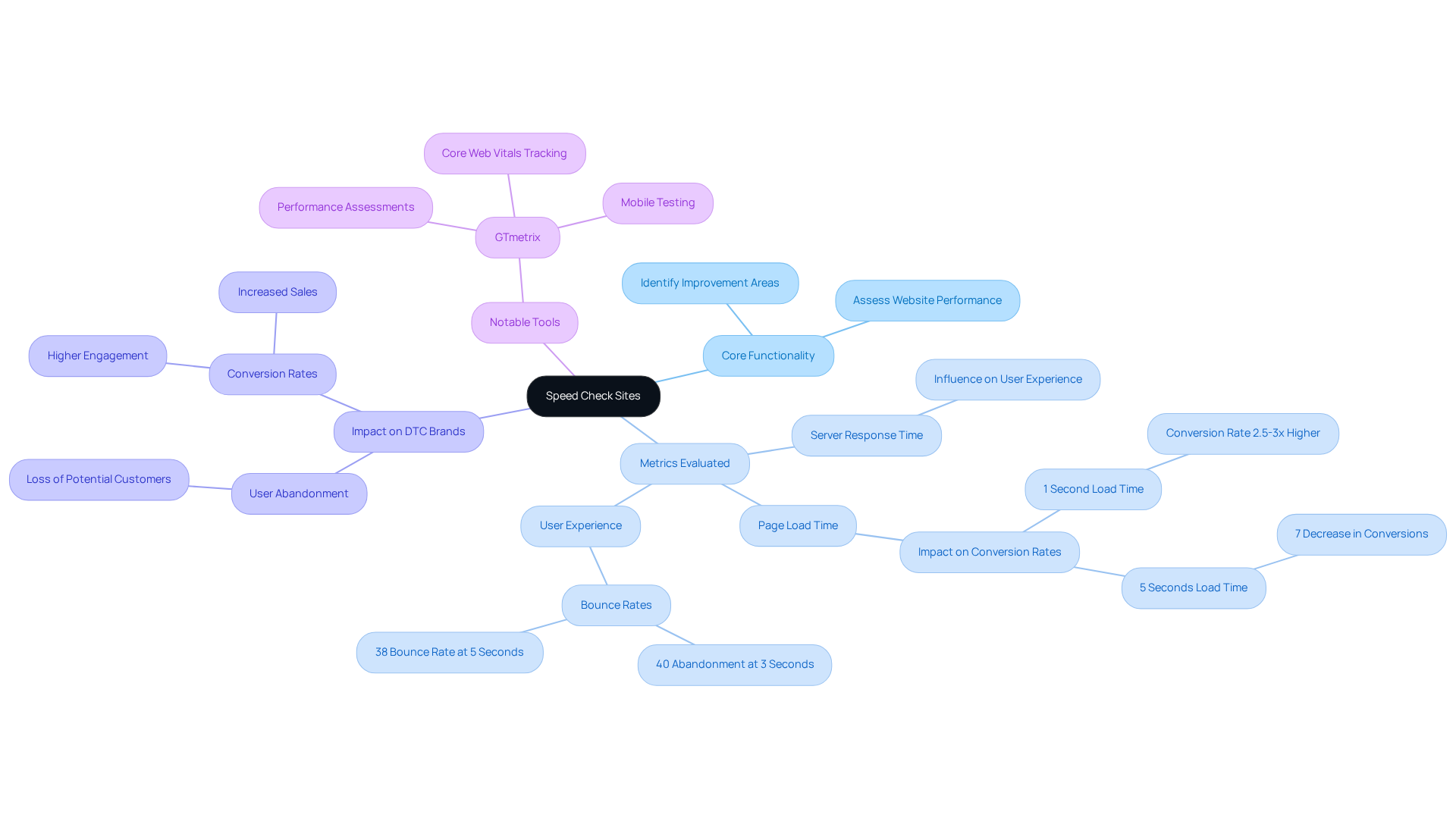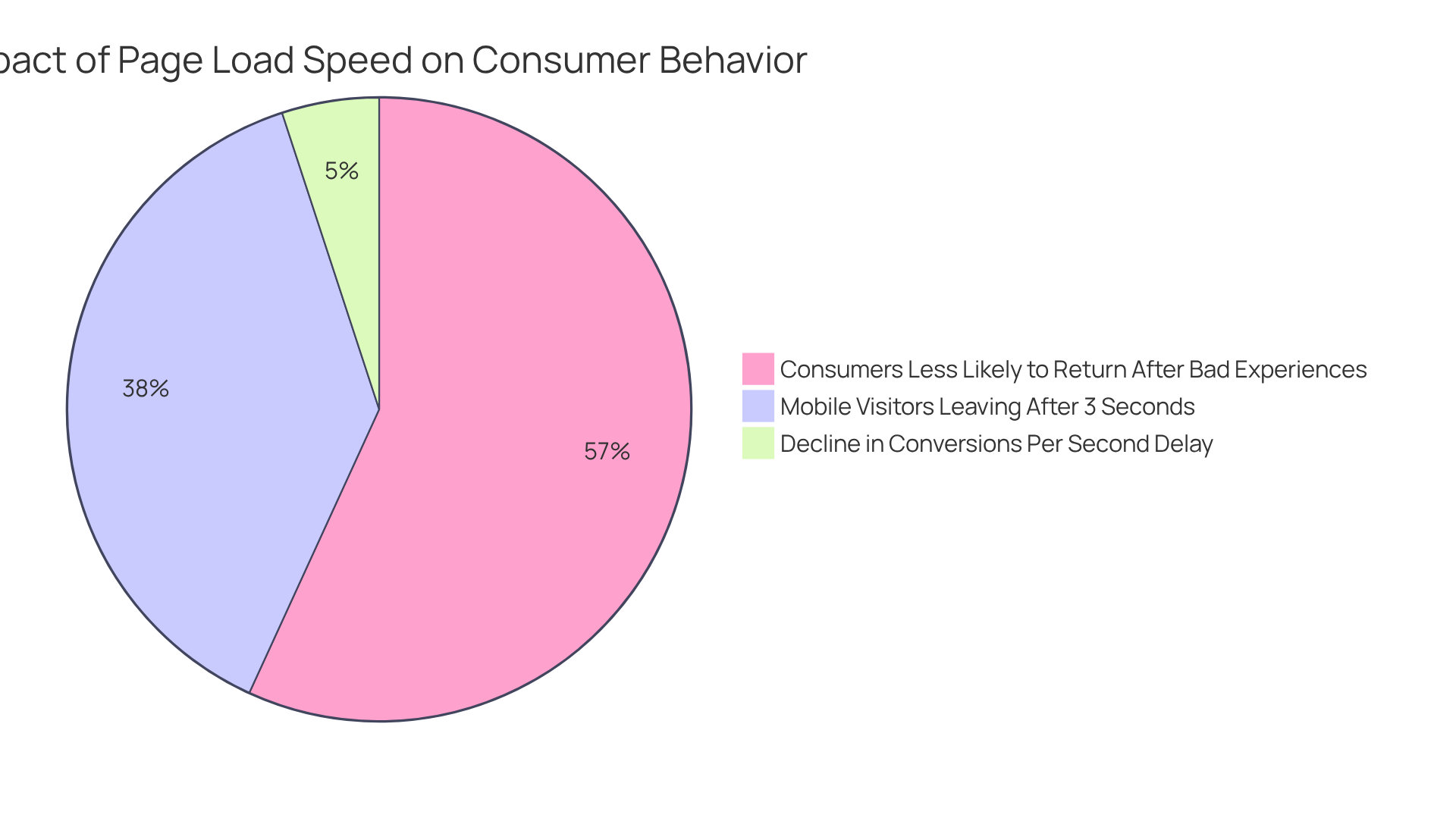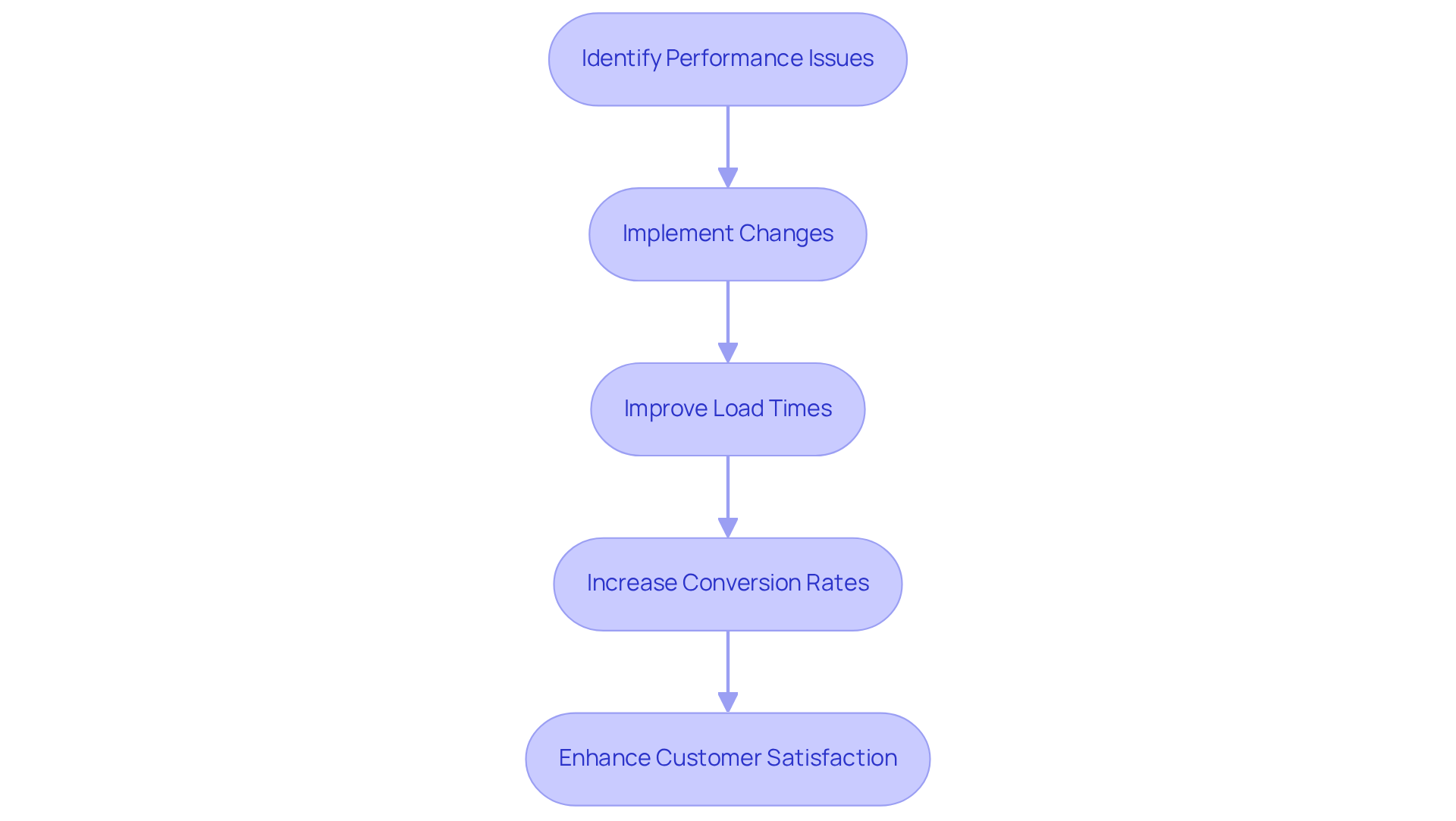
Overview
Speed check sites play a pivotal role in assessing website performance, which directly influences user engagement and conversion rates for direct-to-consumer (DTC) brands. A mere delay in page load time can lead to a significant drop in conversions. This stark reality underscores the necessity of these tools for optimizing site speed and enhancing the overall user experience. By leveraging speed check sites, DTC brands can not only improve their performance metrics but also foster a more engaging and efficient interaction with their customers.
Introduction
Understanding website performance is increasingly critical as consumer expectations rise in the digital realm. Speed check sites are essential tools for brands, providing insights that significantly enhance user experience and drive conversion rates. However, with numerous metrics to consider and the constant threat of competitors, brands must effectively leverage these tools to meet and exceed customer demands.
Define Speed Check Sites: Core Concepts and Functionality
Velocity check platforms function as important that assess the loading rate and overall functionality of websites. These platforms evaluate critical metrics such as page load time, server response time, and user experience, delivering a comprehensive performance score that identifies areas in need of improvement.
For direct-to-consumer (DTC) brands, these tools are indispensable, as website performance directly influences user engagement and conversion rates. Research indicates that a webpage loading in one second can achieve conversion rates 2.5 to three times greater than one that takes five seconds. Furthermore, the typical conversion rate for online retail sites ranges from 1.84% to 3.71%, underscoring the significant impact of efficiency on sales. A mere one-second delay can result in a 7% decrease in conversions, while 40% of users abandon a site that takes longer than three seconds to load. This underscores the urgency of optimizing website performance to enhance customer retention and drive sales.
Notable performance check tools, such as GTmetrix—which has analyzed over 1.3 billion pages—function as a speed check site by offering detailed evaluations, including waterfall charts and Core Web Vitals tracking, enabling brands to observe performance trends over time. By leveraging these insights, businesses can implement targeted optimizations, ensuring their websites align with the expectations of today's fast-paced digital consumers. Additionally, optimizing for various devices is crucial, as mobile browsing constitutes a significant portion of web traffic. Upcoming changes to global test servers may also impact the functionality of these tools, making it imperative for brands to remain informed.

Contextual Importance: Why Speed Check Sites Matter for DTC Brands
For DTC brands, speed check sites are essential, significantly impacting user experience and conversion rates. Research indicates that even a one-second delay in page response time can lead to a staggering 7% decline in conversions. In today's rapid digital environment, consumers expect websites to display almost instantaneously. Failure to meet these expectations can result in lost clients who turn to rivals.
Moreover, search engines like Google consider site speed a crucial factor in their ranking algorithms. This makes it imperative for brands to prioritize speed optimization. Enhancing site speed not only improves visibility but also attracts more traffic, ultimately driving sales and fostering customer retention. Notably, 53% of mobile visitors will exit if a page requires more than 3 seconds to display. Additionally, a mere two-second delay in web page display time can raise bounce rates by an alarming 103%.
As highlighted by Parah Group, "Page load time refers to the duration it takes for a webpage to fully load in a user’s browser, significantly affecting user satisfaction and engagement." Furthermore, 79% of consumers who are unhappy with a website's functionality are less inclined to buy from the same site again. This underscores the essential in retaining customers and driving repeat business.

Historical Development: The Evolution of Speed Check Sites
The origins of performance testing can be traced back to the late 1990s, when the first tools emerged primarily to measure basic connection rates. As internet usage surged and websites grew in complexity, the limitations of these early tools became evident. This shift triggered a transition towards more advanced evaluation analysis, addressing not only connection rates but also various metrics essential to user experience.
Today, provide comprehensive insights, including mobile responsiveness, load times, and user engagement factors. This evolution underscores the critical role that website efficiency plays in achieving business success in the digital landscape.
Experts assert that the development of these tools has been pivotal, with advancements enabling brands to optimize their online presence effectively. The focus has shifted from merely assessing speed to understanding how effectiveness influences user behavior and conversion rates.
In fact, statistics reveal that for every additional second of page load time, conversion rates decrease by an average of 2.11%. Furthermore, 79% of buyers who encounter website issues indicate they are unlikely to revisit the platform for future purchases. This underscores the necessity of continuous evaluation as a vital component of digital strategy.

Key Features: What Makes an Effective Speed Check Site
A functional velocity assessment platform is essential for optimizing website performance. Real-time activity analysis stands out as a critical feature, allowing users to monitor their site's performance on a speed check site under various conditions. Detailed reporting on load times is imperative; it provides insights into how quickly pages render and identifies potential bottlenecks. Actionable recommendations for improvement, such as image compression and script minification, empower website owners to enhance user experience and drive conversions.
Moreover, the tool must facilitate testing across various devices and browsers, offering comprehensive insights into functionality variations. Tools like Google PageSpeed Insights and GTmetrix exemplify this approach by providing and identifying specific areas for optimization. Research indicates that even a minor 1-second delay in page rendering can significantly reduce conversion rates, which underscores the necessity for brands to prioritize performance optimization on their speed check site. Furthermore, statistics from a speed check site reveal that 40% of users will abandon a page if it takes more than 3 seconds to load, highlighting the critical nature of performance evaluations. By leveraging these features, website owners can make informed decisions that not only improve loading times but also foster stronger relationships with their customers.

Practical Applications: How DTC Brands Utilize Speed Check Sites
DTC brands leverage performance check sites to rigorously evaluate their website efficiency and implement necessary enhancements. For example, a brand might discover through a performance test that their homepage experiences delays in loading due to unoptimized images. By rectifying this issue, they can markedly enhance load times, which in turn leads to increased conversion rates and improved customer satisfaction. Furthermore, brands can utilize a to benchmark their performance against competitors, ensuring they maintain a competitive edge in the rapidly evolving digital marketplace.

Conclusion
Speed check sites are indispensable tools for evaluating and enhancing website performance, especially for direct-to-consumer brands. Their importance stems from their capacity to deliver critical insights into loading times, user experience, and overall site efficiency. By utilizing these platforms, businesses can pinpoint performance bottlenecks and implement essential optimizations to satisfy the high expectations of today's digital consumers.
The article underscores several key points, notably the direct correlation between page load speed and conversion rates. Research shows that even a minor delay in loading can result in substantial declines in user engagement and sales. Furthermore, the historical evolution of speed check sites illustrates their increasing significance in the digital landscape, evolving from basic connection rate measurements to comprehensive performance evaluations. Features such as real-time analysis, detailed reporting, and actionable recommendations are vital for brands striving to optimize their online presence.
Ultimately, the insights derived from speed check sites transcend mere metric improvement; they focus on enhancing customer satisfaction and driving business success. As the digital marketplace continues to evolve, prioritizing website performance is essential for retaining customers and maintaining competitiveness. Brands are urged to actively leverage these tools to ensure their websites not only meet but surpass user expectations, thereby fostering loyalty and boosting conversion rates.
Frequently Asked Questions
What are speed check sites and their primary function?
Speed check sites, also known as velocity check platforms, assess the loading rate and overall functionality of websites. They evaluate critical metrics such as page load time, server response time, and user experience, providing a comprehensive performance score to identify areas needing improvement.
Why are speed check sites important for direct-to-consumer (DTC) brands?
For DTC brands, speed check sites are vital because website performance directly influences user engagement and conversion rates. Faster loading times can significantly enhance conversion rates, while delays can lead to lost customers and decreased sales.
What impact does page load time have on conversion rates?
Research shows that a webpage loading in one second can achieve conversion rates 2.5 to three times greater than one that takes five seconds. A one-second delay can result in a 7% decrease in conversions, and 40% of users abandon sites that take longer than three seconds to load.
What tools are commonly used for website performance checks?
Notable tools like GTmetrix analyze website performance by providing detailed evaluations, including waterfall charts and Core Web Vitals tracking, allowing brands to observe performance trends and implement targeted optimizations.
How does site speed affect search engine rankings?
Site speed is a crucial factor in search engine ranking algorithms, particularly for Google. Prioritizing speed optimization can improve visibility, attract more traffic, and ultimately drive sales and customer retention.
What are the consequences of slow loading times on mobile devices?
53% of mobile visitors will exit a page that takes more than three seconds to load. Additionally, a two-second delay can increase bounce rates by 103%, highlighting the necessity of optimizing for mobile browsing.
How does page load time influence customer retention?
Page load time significantly affects user satisfaction and engagement. 79% of consumers who are unhappy with a website's functionality are less likely to purchase from that site again, emphasizing the importance of speed in retaining customers and driving repeat business.
FAQs











